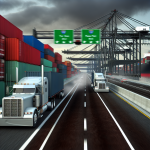BNSF Railway turned in a stronger third quarter under Berkshire Hathaway, posting higher operating earnings even as the broader freight economy remains uneven. Berkshire’s Saturday filing shows BNSF generated $1.45 billion in operating earnings in the quarter, up from $1.38 billion a year ago, with year‑to‑date operating earnings rising to $4.13 billion from $3.75 billion.
For trucking, the headline isn’t just a better quarter at a western Class I. It’s that rails are tightening the screws on cost and service at the very moment contract talks and peak‑season planning roll through retail supply chains. Berkshire’s operating earnings jumped 34% in the quarter to $13.49 billion, a reminder that its largest non‑insurance platform — led by BNSF — is contributing more profit as the company heads into a leadership transition. The same disclosure pegs Berkshire’s net earnings at $30.8 billion for the quarter.
Rails also have fresh proof points on efficiency. Canadian National, a key competitor for transcontinental import flows, reported a third‑quarter operating ratio of 61.4% — an improvement of 170 basis points — alongside modest revenue growth. That puts a marker down for network speed and reliability as trans‑Pacific imports cycle through West Coast ports and into inland ramps. When trains run faster and more predictably, intermodal becomes a sharper pricing weapon against long‑haul truckload on lanes like Southern California–Chicago and the I‑40/I‑70 corridors.
Berkshire’s record cash pile — $381.7 billion at September 30 — and another quarter with no buybacks underscore how much dry powder sits behind BNSF. Even if Berkshire is cautious on deals, a well‑funded parent supports steady rail capex and service initiatives that can keep intermodal competitive with highway in 2026 bid cycles. For truckers, that tends to show up as: more aggressive rail‑plus‑dray options on dense lanes, tougher rate defensibility for 53‑foot dry van over 700–1,200 miles, and stickier contract share shifts toward intermodal where time sensitivity is lower.
What’s underneath the numbers matters for carriers and brokers:
- Intermodal leverage: When a Class I improves profitability without leaning on revenue growth, the savings often come from network velocity, asset turns and crew productivity. Those gains let railroads price to convert highway freight while preserving margins — a risk flag for truckload incumbents on long hauls, and an opening for drayage fleets at LA/LB, Dallas–Fort Worth and Chicago ramps.
- Fuel‑surcharge dynamics: Rails’ per‑unit revenue is sensitive to surcharge math, just like trucking. As diesel volatility abates, the comparative edge shifts back to service and line‑haul economics — an area where recent rail efficiency gains can tip bids against over‑the‑road options on predictable flows.
- Mixed freight resilience: Coal’s structural headwinds don’t map to trucking, but grain, autos and retail intermodal do. BNSF’s year‑to‑date profit lift suggests those economically sensitive buckets have been managed tightly enough to keep margins expanding — a sign customers are finding capacity and service reliability on the rails, not just price.
What to watch next if you run trucks or buy truckload:
- Fourth‑quarter service metrics from Class I peers. If CN’s OR improvement is echoed by others, expect intermodal marketing companies to press for longer‑haul conversions in early‑2026 bid rounds.
- Berkshire’s capital allocation color in year‑end communications. A still‑swelling cash balance gives BNSF a wide berth to keep pushing capacity projects and terminal upgrades — the feedstock for faster turns and denser intermodal schedules that directly challenge highway share.
Bottom line for the trucking audience: A more profitable, faster railroad is a more assertive competitor. BNSF’s third‑quarter step‑up, along with a cash‑rich owner, points to sustained pressure on long‑haul dry van rates in 2026, with offsetting opportunities in drayage, transload and short‑haul truckload that tie into ramp networks.
Sources: FreightWaves, Berkshire Hathaway, The Wall Street Journal, Associated Press, Canadian National (GlobeNewswire)
This article was prepared exclusively for TruckStopInsider.com. Republishing is permitted only with proper credit and a link back to the original source.





